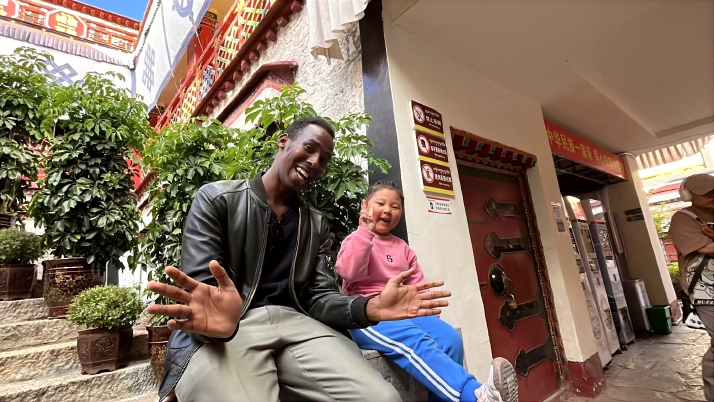| Lifestyle |
| Dancing on the Roof of the World | |
|
|
 Musab Abdikadir befriends a local girl while visiting the Potala Palace in Lhasa, Xizang Autonomous Region, on October 10, 2024 (COURTESY PHOTO)
'Musab, I am sending you New Year greetings from the peak of the world!" This message, which I received at the start of 2025, ranks among my favorite New Year greetings of the year because it came from a friend I made in Xizang Autonomous Region during a cultural trip last year. It reminded me of the mesmerizing landscapes and, more importantly, the incredible people whose warmth and hospitality made my time there unforgettable. The journey to Xizang was the realization of a long-held fascination, nurtured during the vibrant Tibetan dances at Minzu University of China (MUC) in Beijing. Every Friday night, the campus would come alive as students from diverse backgrounds gathered in circles, swaying together in Tibetan dance. Normally, the dance is led by beautifully dressed students in traditional Tibetan attire; they form the inner circle and radiate an infectious energy that captivates everyone, helping students in outer circles to easily follow the dance moves. These communal dances, where elegant moves seamlessly bridged cultures, not only sparked my curiosity but deeply moved me. They highlighted the power of dance to unite people across different ethnic groups, celebrating the rich cultural and natural landscape of Xizang. Intrigued by these interactions and the beauty of Tibetan culture, I often dreamed of dancing atop the Qinghai-Xizang Plateau—the "roof of the world." This dream became a reality when MUC co-organized a cultural trip with Minzu Huabao, a pictorial magazine documenting China's ethnic minority culture, offering a valuable opportunity to experience and engage with the culture I had come to admire from afar. Upon arrival in Lhasa, the challenge of adapting to the high altitude at over 3,000 meters was daunting. Equipped with advice and medication recommended by friends, alongside support from our school and the regional government, which provided doctors and all necessary equipment, I braced myself for the physical adjustments. Despite my initial concerns, the overwhelming reaction I experienced was not physical discomfort but rather a profound emotional response to the warmth and generosity of the Tibetan people. Their spirit, far more impactful than the thin air, touched my heart deeply, making the acclimatization process a secondary concern to the rich human connections formed. The depth of spiritual and cultural richness I encountered in Xizang was embodied in the everyday interactions with the locals. Their light-hearted yet spiritually deep demeanor was touching, enhancing my connection to the region. This was reflected not just in their actions but also in their cuisine, which became a transformative element of my journey. The taste of fresh, creamy butter and the discovery of butter tea were nothing short of revelatory. Each sip and bite deepened my understanding of Tibetan culture, revealing culinary delights that were previously unknown to me. Our exploration of Lhasa and Xigaze was marked by engaging visits to significant cultural sites, enhanced by our guides' passionate storytelling. We visited the majestic Potala Palace, admired the architectural beauty of Palkhor Chode Monastery, strolled through the bustling Barkhor Street and spent time at the revered Jokhang Temple and Shalu Monastery. Our guide shared insights into the global significance of these sites, explaining that devotees not only travel from distant regions within China but also from other countries to undertake their religious pilgrimages. We visited the village of Nudu, which is recognized as a model for ethnic unity and progress. During our visit, we spoke with the village head. He emphasized that one of his main economic objectives is to raise the average personal income of the village residents. By continuing to improve living standards, he aims to sustain the village's status as a model for progress. This journey not only brought me closer to fulfilling my dream of visiting all provincial-level regions in China but also deepened my appreciation for the intricate tapestry of human connections across cultural boundaries. On my final night in Xizang, I participated in a traditional Tibetan dance, a full-circle moment that mirrored the dances back at MUC. With a cup of butter tea, surrounded by both old and new friends, I realized my dream of truly experiencing Xizang, where every dance step and every shared cup of tea is a testament to the enduring warmth and spirit of its people, and a reminder that people are always central to our experiences. BR The author is a Somali graduate student studying ethnology at Beijing-based Minzu University of China Copyedited by G.P. Wilson Comments to linan@cicgamericas.com |
|
||||||||||||||||||||||||||||||
|